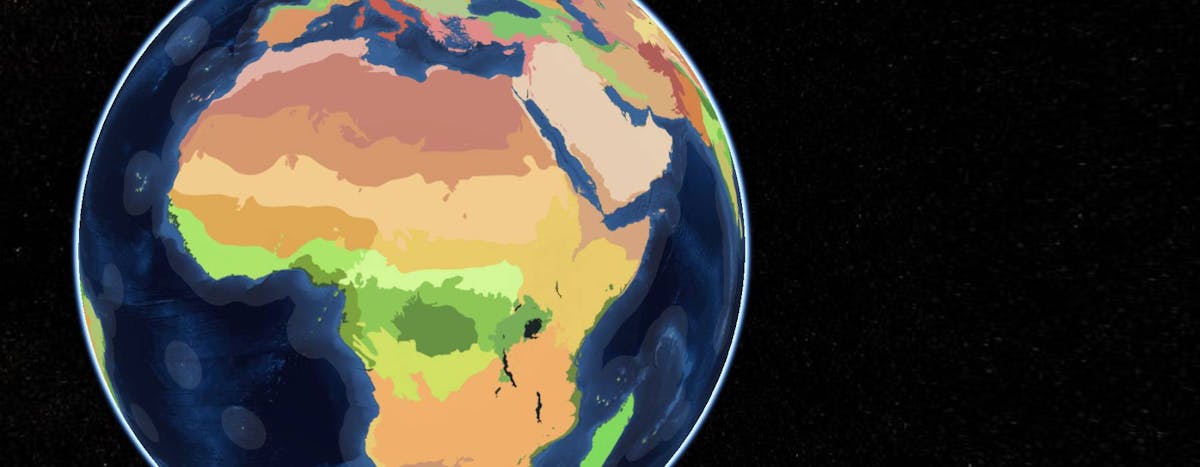Bioregions: Nature's Map of the Earth
Explore Bioregions by Realm
The One Earth Bioregions Framework is organized by the world's major biogeographical realms, the broadest divisions of Earth's land surface in which ecosystems and groupings of organisms share a common evolutionary history. These roughly correspond to the major continents of the Earth but are further subdivided. For example, the Neotropical realm is divided into Central America and Southern America. One Earth utilizes these 14 realm divisions—further divided into 52 habitable subrealms, 185 bioregions, and 844 ecoregions—as a framework to better understand the natural world that surrounds us.
- Subarctic America
Subarctic America covers most of Canada and Alaska. It is the northern section of the Nearctic realm with four subrealms as defined in the One Earth Bioregions Framework—Greenland, Canadian Tundra, Canadian Boreal Forests, and Alaska—containing nine bioregions in total.
- Northern America
Northern America contains the majority of the Nearctic realm, spanning from southern Canada to northern Mexico and containing six subrealms as defined in the One Earth Bioregions Framework—Northeast American Forests, Southeast US Savannas, Great Plains, American West, Mexican Drylands, and North Pacific Coast—containing 22 bioregions in total with a diversity of biome types.
- Central America
The Central America realm is the upper section of the Neotropics with two major subrealms—Central America and the Caribbean—containing six bioregions in total as defined in the One Earth Bioregions Framework.
- Southern America
Southern America covers most of the Neotropical realm with five major subrealms—Amazonia, Andes Mountains & Pacific Coast, South American Grasslands, Brazil Cerrado & Atlantic Coast, and Upper South America—with 23 bioregions in total as defined in the One Earth Bioregions Framework.
- Afrotropics
The Afrotropics is one of the world’s major biogeographical realms with six major subrealm divisions based on the One Earth Bioregions Framework—Southern Afrotropics, Sub-Equatorial Afrotropics, Equatorial Afrotropics, Madagascar & East African Coast, Sub-Saharan Afrotropics, and the Horn of Africa—containing 24 bioregions in total.
- Subarctic Eurasia
Subarctic Eurasia covers most of the landmass of Russia and the Nordic countries—Iceland, Norway, Sweden, and Finland—and makes up the northern section of the Palearctic realm with four major subrealms as defined in the One Earth Bioregions Framework—Palearctic Tundra, Scandinavian Boreal Forests, Siberian Boreal Forests, and the Sea of Okhotsk & Bering Tundra-Taiga.
- Eastern Eurasia
Eastern Eurasia is the easternmost section of the Palearctic realm, divided into six major subrealms—East Asian Deserts, Tibetan Plateau, Mongolian Grasslands, Central East Asian Forests, Northeast Asian Forests, and Japanese Islands—with 16 bioregions based on the One Earth Bioregions Framework.
- Central Eurasia
Central Eurasia makes up the interior section of the Palearctic realm with five major subrealms—Kazakh Steppes & Hemiboreal Forest, Caspian Sea & Central Asian Deserts, Tien Shan Mountains, Persian Deserts & Forests, and Altai-Sayan Mountains—containing 11 bioregions in total.
- Western Eurasia
Western Eurasia covers most of Europe and is the westernmost section of the Palearctic realm with five major subrealm—European Mixed Forests, European Mountain Forests, Black Sea Forests & Steppe, the Mediterranean, and the Anglo-Celtic Isles—and 13 bioregions in total as defined in the One Earth Bioregions Framework.
- Southern Eurasia
Southern Eurasia corresponds roughly with the Middle East-North Africa (MENA) region and is the southernmost section of the Palearctic with two major subrealms—North Africa and the Greater Arabian Peninsula—and five bioregions in total as defined by the One Earth Bioregions Framework.
- Indomalaya
Indomalaya is one of the world’s eight major biogeographical realms and has three subrealms—the Indian Subcontinent, Southeast Asian Forests, and Malaysia & Western Indonesia—with 18 bioregions in total based on the One Earth Bioregions Framework.
- Australasia
The Australasia realm is dominated by the Australian continent and two additional subrealms—New Zealand and the Australasian Islands & East Indonesia—with 16 bioregions in total as defined in the One Earth Bioregions Framework.
- Antarctica
Antarctica is made up almost entirely of one single bioregion—the ice-covered land mass, coastal tundra, and sea ice of the main continent—which is nearly twice the size of Australia. It contains two additional marine bioregions—the Antarctic Peninsula & Scotia Sea and the Subantarctic Indian Ocean Islands.
- Oceania
Oceania is one of the world’s major biogeographical realms with 11 island bioregions stretching across the Pacific Ocean, including Polynesia, Micronesia, and Hawaii.

One Earth's interactive navigator lets you explore the Earth's bioregions and ecoregions and view active climate solution projects by location.
Launch Navigator
The Global Safety Net (GSN) is the first global-scale analysis of land areas requiring protection to solve the twin crises of biodiversity loss and climate change, upholding and strengthening Indigenous land rights.
Explore The GSN